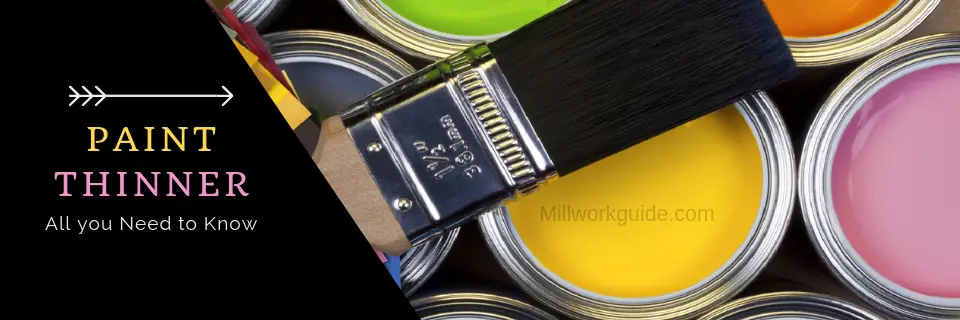Paint Thinner is a compound solvent used to reduce the thickness of the oil-based paints.
In simple terms, it is a solvent to thin oil paints, to clean up tools after their use, and to prepare the demanded flexibility and texture without making any lumps to give your house a smooth and beautiful finishing.
Read on to find out more about the different applications for paint thinners, traditional vs odourless paint thinner, and tips and FAQs!
Contents

Types of Solvents Related to Paint Thinner
- Halogenated Solvents: These are halogenated solvents containing a halogen such as iodine, chlorine, and bornin. To give an example of halogenated solvent i.e. Perchloroethylene a highly effective solvent used in dry cleaning.
- Oxygenated Solvents: These oxygenated solvents are first advanced through chemical reactions from alcohol, ester, glycol ether-ester, ketones and so many more.
- Hydrocarbon Solvents: These solvents are further classified into three sub-categories of solvents i.e. aliphatic, aromatic and piretanide.Paint thinner is the most common and familiar example of Hydrocarbon solvents.
Difference Between a Traditional Paint Thinner and an Odorless Paint Thinner
Traditional Paint Thinner
As we know, paint thinners are the solvents to reduce the thickness of the paint and used for clean-up afterward.
The most regular type of used paint thinner is formed from hundred percent mineral spirits ensuring the best quality and affinity.
They are formed at a 104-degree temperature to achieve the desired level of consistency of thinness.
Odorless Paint Thinner
Odorless paint thinner is believed to be the new substitute for the regular traditional paint thinner formed of turpentine- and many other common types of paint thinners.
And, as the name says, this paint thinner is odorless without the powerful stench of traditional thinner.
Uses and Applications of Paint Thinner
Apart from being used to reduce the thickness of the paints, the paint thinner also has been used for many activities as follows:
Thinning all oil-based paints
The oil-based paints can be very thick to directly paint with them can be quite difficult to apply coats and will take longer than necessary to dry.
The paint thinner can be used in thinning the paint to make it easy to apply and giving a proper polished look.
Clean Up
It could take you hours to clean up the used tools with water and even then it will not be completely cleaned.
It will be just wasting time, water, and energy.
Instead, you can use paint thinner and clean your tools in a few minutes.
It is an important application of paint thinner to help clean-up the tools after the work has finished.
To cite an example, it can help post-work to clean up rollers, paint brushes, roller trays, and a good deal of other equipment.
It is very simple to use paint thinner to clean the tools, just dip the equipment and tools in the thinner.
Leave it there for a few minutes, allowing the thinner to reach all the part of the tools.
Further, take it out after 2-3 minutes and wipe it clean with the help of a newspaper.
The paint thinner is also been used to clean the wood before coating it and giving a smooth refinish in the end.
Personal Cleanup
It could be really difficult to get paint off your hands and arms.
You can spend your entire day trying scrubbing the paint but it won’t budge giving you, even more dry and sore hands with all the paint scraping.
In this situation, you can save a lot of time and hard work by applying a little amount of thinner on cotton and rubbing it on the areas where you want to remove the paint from.
Afterward, rinse your hands with soap and water.
Make sure to not to use an excessive amount of the thinner on your skin, considering that it will remove paint easily. It’s excessive use can give you skin burns.
Removing Oil Stains From Concrete
It is not only difficult but impossible to get oil stains out of your walls and floors.
But if you are aware of the magic of paint thinner, you won’t worry about the oil stains on your garage surface or anywhere in your house.
Directly applying thinner on the surface could leave marks.
To avoid marks, use a small amount of the paint thinner in sawdust.
Thereafter, spread the paint thinner soaked sawdust on the oil stains to remove the stain and soak the oil as well as the paint thinner.
Substitutes of Paint Thinner
There are many substitutes available in the market for the paint thinner. But mineral spirits and acetone are the most common substitutes.
Mineral Spirits: It is more expensive than the paint thinner, but is less toxic and easier to handle.
Unlike paint thinner, it can be used on many other paints apart from oil-based paints such as lacquer and shellac-based paints.
Acetone: Another common paint solvent substitute of paint thinner.
It is cheaper without any risks to your health. But it is a mild paint solvent and can’t perform all the tasks of the paint thinner and other strong substitutes.
It depends on the types of paint you’re using to use acetone as a solvent.
Things to Remember While Using/Working with Paint Thinners
Exposure to paint thinners can be very dangerous, the vapors created by the containing paint thinner could be very hazardous for health.
Well ventilated environment
Keep in mind whenever you’re working with paint thinners, work in a well-ventilated area.
Keep the doors and windows open for better and faster circulation of fresh air and recycling the old one.
Use an exhaust fan, if you’re working in a less ventilated work environment.
The exposure to paint thinner can lead to headache, breathing problems, and many other health related issues.
Keep it away from acidic substances
Don’t ever keep acidic substances along with a paint thinner because paint thinners have a bad reaction to chemicals leading to an explosion.
Be safe and keep them separately.
Never keep paint thinner near food and other eatables
Never eat food in the presence of thinners, or while handling thinners.
The paint thinners can easily contaminate your food, and you might unknowingly ingest paint thinner, which is very hazardous for your health.
If you want to eat between your work, don’t eat where you’re working with thinner.
Go outside and eat while wearing gloves in your hands to avoid ingesting the paint thinner.
Wear safety equipment
Always remember to wear safety glasses and mask while working with paint thinner for your safety and protection against it vapors and fumes.
Don’t smoke under or near paint thinner
Keep away all the combustible and heat substances away from the paint thinner.
And smoking in presence of or even near the paint thinners can lead to uncontrolled flames if the thinner catches it.
Proper disposal of the paint thinners
Don’t dispose paint thinners like you dispose off other waste material in the trash, or in the drain or flush down the toilet.
Follow the rules and regulations while disposing it off.
Safe and Protected Storage
Keep the leftover thinner in a safe, tight- protected container and inaccessible place by children, or other untrained people to use thinner.
Always wash your hands after use
Always wash your hands with soap and water after finishing completing your work, lessening the risk of ingesting paint thinner through your hands into your mouth.
The clothes and rags used while working should be disposed properly into water to avoid the risk of flames.
Useful Tips
- Never leave a paint thinner open for a long, it could evaporate causing nausea and breathing problems.
- Mix the thinner slowly into the paint so it could dissolve properly into the paint.
- It should be mixed with a paint at room temperature.
- Before starting, test the mixture on the surface by applying one or two coats to see that paint is neither too thick nor too thin.
- Don’t use a cold paint because it might cause its thickness and compatibility.
FAQ’s Related to Paint Thinners
- Can paint thinner be added to water-based paint?
No, there is no use of adding paint thinner to water-based paints because they are diluted enough already. Moreover, it could further completely spoil the paint if paint thinner is added to it.
- Why are Paint Thinners Flammable?
The paint thinners are combustible and can easily cause fire because of its vapors and fumes, if not handled with utmost care. If they are even taken near to heat, they might result in an explosion.
- Are paint thinners inflammatory? If yes why?
Yes, paint thinners are inflammatory because they are very poisoning for your airways and lungs.
As paint thinner is a hydrocarbon which could easily spread inflammation to your lung tissue from mild to even severe.
On the other hand, if it is a long-term hydrocarbon inhalation can even lead to irregular heart rhythms, liver-kidney damage, nervous system disorder, and even anemia or leukemia.
Paint Thinners – Conclusion
We hope you’ve found this article helpful in learning more about the applications and uses of paint thinner!
You can browse Amazon’s range of paint thinners here.
Here are some related articles that you may also enjoy reading:
Best Finishes for Wood Kitchen Table
Best Varnishes for Wood
Teak Oil vs Tung Oil vs Danish Oil

About The Author: Hi There! I’m Dave. I’m a certified millworker and carpenter, and have been working in the industry for over 10 years. I created this website to pass on my knowledge so that other enthusiasts, no matter what their skill level, can enjoy the craft as much as I do. I hope you enjoy!
